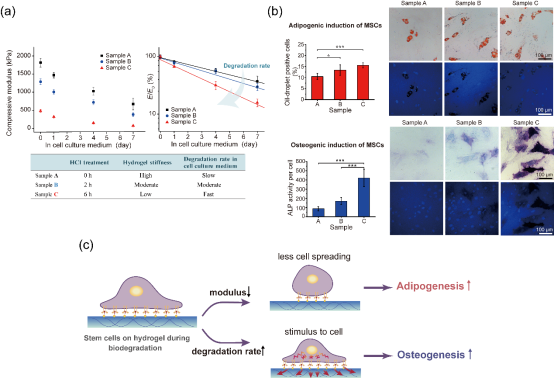 +565 975 658
+565 975 658
 info@premiumcoding.com
info@premiumcoding.com
 Monday - Friday, 8.00 - 20.00
Monday - Friday, 8.00 - 20.00
Ding’s Group Reveals a Dynamic Cue to Regulate Stem Cells Degradation Rate of Materials
While various static cues such as matrix stiffness have been known to regulate stem cell differentiation, it is unclear whether or not dynamic cues such as degradation rate can influence cell behaviors beyond simple integration of static cues such as decreased matrix stiffness.
By combining biodegradable macromonomer synthesis, block copolymer micelle nanolithography and transfer lithography, Ding’s group prepared nonfouling biodegradable hydrogels decorated with a nanoarray of cell-adhesive arginine-glycine-aspartate peptide. They further examined adhesion and differentiation of mesenchymal stem cells (MSCs) on the hydrogel surfaces with well-controlled degradation rates in cell culture media. Both the matrix stiffness and degradation rate influenced the cell behaviors; while adipogenic differentiation of MSCs can be understood by the lowered stiffness, the osteogenic differentiation was contradictory with common sense because an enhanced osteogenesis on soft hydrogels was found. Higher degradation rates were suggested to account for this interesting phenomenon in the sole osteogenic/adipogenic induction and even more complicated trends in the co-induction. Hence, the degradation rate is a dynamic cue to regulate cells, which should be paid attention to in design of degradable biomaterials for regenerative medicine.

The paper has been published in the journal Biomaterials with Ms. Yuanmeng Peng, a master student supervised by Professor Jiandong DING as the first author. See details: Yuanmeng Peng, Qiong-Jie Liu, Tianlei He, Kai Ye, Xiang Yao, and Jiandong Ding*, Degradation rate affords a dynamic cue to regulate stem cells beyond varied matrix stiffness, Biomaterials, 178, 467-480 (2018).
Get to know us better now!

Wechat:FDUMMers
Search!
Search across our website
Revenant @ 2018 by fudan | All Rights Reserved
Powered by Weicheng

